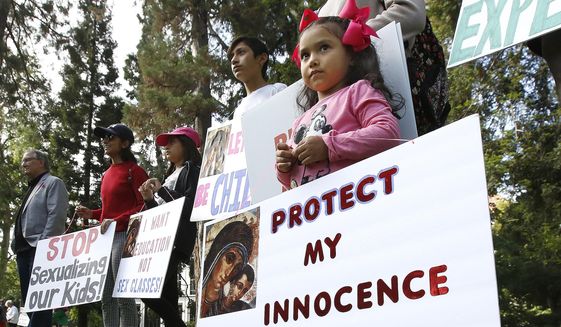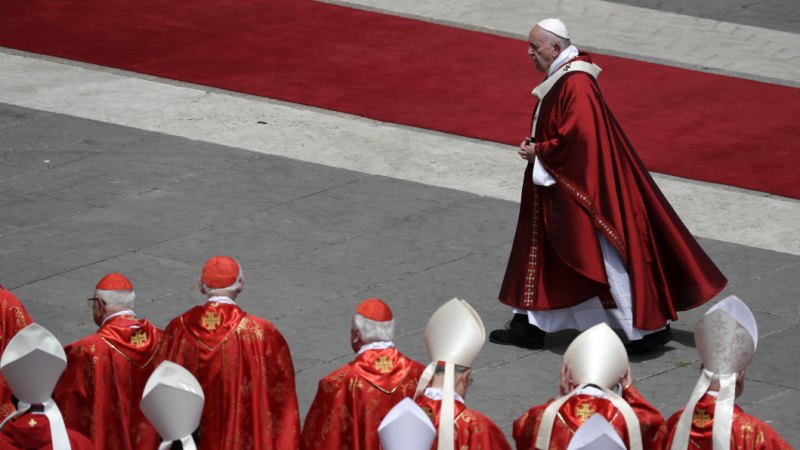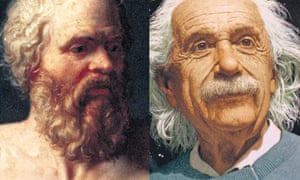- In Vatican
- Inés San Martín Jun 21, 2019
ROME - Pope Francis on Friday visited the southern Italian city of Naples and participated in a theology congress dedicated to interreligious dialogue and migration in the context of the Mediterranean Sea.
The Argentine pontiff revisited some of his core concepts, calling for theologians to be an expression of a church that is a “field hospital,” and to be merciful, because without this, “our theology, our law, our pastoral care, run the risk of collapsing into bureaucratic pettiness or ideology, which by its nature wants to tame the mystery.”
The theology summit was organized by the Pontifical Catholic University, a Jesuit institution. The scope of the gathering was to discuss the impact of the pope’s Apostolic Constitution Veritatis Gaudium, on theological studies. His speech was entitled “Theology after Veritatis Gaudium in the context of the Mediterranean.”
“Theology is the expression of a church that is a ‘field hospital,’ which lives its mission of salvation and healing in the world!” Francis said.
“Mercy is not only a pastoral attitude, but it is the very substance of the Gospel of Jesus,” he said. “I encourage you to study how, in the various disciplines - dogmatic, morals, spirituality, law and so on - the centrality of mercy can be reflected,” Francis said to around 1,000 people, including students and professors.
In the journey of leaving oneself and encountering others, it is important for theologians to be “men and women of compassion, touched by the oppressed life of many, by the slavery of today, by social wounds, by violence, by wars and from the enormous injustices suffered by so many poor who live on the shores of this ‘common sea’.”
“Without communion and without compassion, constantly nourished by prayer, theology not only loses its soul, but loses its intelligence and ability to interpret reality in a Christian way,” Francis said.
Francis also underlined the importance of universities having study plans that allow lay people, particularly women, to attend and not only seminarians.
“The contribution that women are giving and can give to theology is indispensable and their participation must therefore be supported,” he said.
Speaking in particular about the context of the Mediterranean - which he’s often dubbed the mare mortum for the number of people who’ve died trying to reach the European shore after fleeing hunger, violence and persecution in Africa and the Middle East - Francis said that it must be “in harmony” with the spirit of Christ, “with his freedom to go around the world and reach the peripheries, even those of thought.”
According to Francis, theologians are called to encourage “the meeting of cultures” with God’s revelation and the Church’s tradition, and even though “the ancient architectures of thought, the great theological syntheses of the past are mines of theological wisdom, they cannot be applied mechanically to current questions.”
The first sources of theology, meaning the Word of God and the Holy Spirit are, the pope said, “inexhaustible” and therefore, theologians are called to work towards a “theological Pentecost.”
Francis also said that “theological freedom” is necessary, because without the possibility of experiencing new paths, “nothing new is created” and there’s no room left for the newness of the Spirit.
Quoting his apostolic exhortation Evangelii Gaudium, written by the Argentine pontiff in 2013, Francis said that, “For those who long for a monolithic body of doctrine guarded by all and leaving no room for nuance, this might appear as undesirable and leading to confusion. But in fact such variety serves to bring out and develop different facets of the inexhaustible riches of the Gospel.”
The theology that should follow Veritatis Gaudium, according to the pontiff, is one that is done “in net,” and in the context of the Mediterranean, “in solidarity with the ‘castaways’ of history.”
The work of theological faculties and ecclesiastical universities, he said, contributes to building a “just and fraternal society,” that cares for creation and is set on building peace as the result of the collaboration between civil, ecclesial and interreligious institutions.
Francis also spoke about the importance of dialogue among Christians, Muslims and Jews, particularly as a tool that can foster understanding and peace.
“With Muslims we are called to dialogue to build the future of our societies and our cities; we are called to consider them partners to build a peaceful coexistence, even when there are shocking episodes by fanatical groups that are the enemy of dialogue, such as the tragedy of last Easter in Sri Lanka,” the pope said, referring to the deadly bombings in three churches and two hotels on Easter Sunday that left over 250 people dead.
Being docile to the work of the Spirit when it comes to theology, Francis said, means to proclaim the faith without a spirit of conquest or the will to proselytize. Instead, it implies a dialogue “from within,” with men and women, their cultures and different religious traditions.
If theology is to be consistent with the Gospel, it must also be open to the testimony “up to the sacrifice of life,” Francis said, quoting as examples Charles de Foucauld and the monks of Tibhirine, murdered in Algeria and “many brothers and sisters who, with the grace of Christ, they were faithful with meekness and humility and died with the name of Jesus on their lips and mercy in their hearts.”
Non-violence, he said, is a “horizon” to which theology must look as a constitutive element, with the help of the writings and practices of Martin Luther King, Italian philosopher Lanza del Vasto and “other artisans” of peace.
Lastly, Francis also urged theologians to work in an “interdisciplinary” way, overcoming “individualism.”
“The method of dialogue and listening, guided by the evangelical criterion of mercy, can greatly enrich the interdisciplinary knowledge and interpretation,” he said, making the prophecies of peace that the Holy Spirit “has never failed to arouse” emerge.
Francis spoke of this as a contrast to the “aggressive and warlike” attitudes that have marked the inhabitants of the Mediterranean, many of whom called themselves Christians: From colonial practices to the justifications of all kinds of wars and the persecutions perpetrated in the name of religion or an alleged racial or doctrinal purity.
Follow Inés San Martín on Twitter: @inesanma
https://cruxnow.com/vatican/2019/06/21/in-naples-pope-francis-warns-theologian-against-collapsing-into-ideology/
The theology summit was organized by the Pontifical Catholic University, a Jesuit institution. The scope of the gathering was to discuss the impact of the pope’s Apostolic Constitution Veritatis Gaudium, on theological studies. His speech was entitled “Theology after Veritatis Gaudium in the context of the Mediterranean.”
“Theology is the expression of a church that is a ‘field hospital,’ which lives its mission of salvation and healing in the world!” Francis said.
“Mercy is not only a pastoral attitude, but it is the very substance of the Gospel of Jesus,” he said. “I encourage you to study how, in the various disciplines - dogmatic, morals, spirituality, law and so on - the centrality of mercy can be reflected,” Francis said to around 1,000 people, including students and professors.
In the journey of leaving oneself and encountering others, it is important for theologians to be “men and women of compassion, touched by the oppressed life of many, by the slavery of today, by social wounds, by violence, by wars and from the enormous injustices suffered by so many poor who live on the shores of this ‘common sea’.”
“Without communion and without compassion, constantly nourished by prayer, theology not only loses its soul, but loses its intelligence and ability to interpret reality in a Christian way,” Francis said.
Francis also underlined the importance of universities having study plans that allow lay people, particularly women, to attend and not only seminarians.
“The contribution that women are giving and can give to theology is indispensable and their participation must therefore be supported,” he said.
Speaking in particular about the context of the Mediterranean - which he’s often dubbed the mare mortum for the number of people who’ve died trying to reach the European shore after fleeing hunger, violence and persecution in Africa and the Middle East - Francis said that it must be “in harmony” with the spirit of Christ, “with his freedom to go around the world and reach the peripheries, even those of thought.”
According to Francis, theologians are called to encourage “the meeting of cultures” with God’s revelation and the Church’s tradition, and even though “the ancient architectures of thought, the great theological syntheses of the past are mines of theological wisdom, they cannot be applied mechanically to current questions.”
The first sources of theology, meaning the Word of God and the Holy Spirit are, the pope said, “inexhaustible” and therefore, theologians are called to work towards a “theological Pentecost.”
Quoting his apostolic exhortation Evangelii Gaudium, written by the Argentine pontiff in 2013, Francis said that, “For those who long for a monolithic body of doctrine guarded by all and leaving no room for nuance, this might appear as undesirable and leading to confusion. But in fact such variety serves to bring out and develop different facets of the inexhaustible riches of the Gospel.”
The theology that should follow Veritatis Gaudium, according to the pontiff, is one that is done “in net,” and in the context of the Mediterranean, “in solidarity with the ‘castaways’ of history.”
The work of theological faculties and ecclesiastical universities, he said, contributes to building a “just and fraternal society,” that cares for creation and is set on building peace as the result of the collaboration between civil, ecclesial and interreligious institutions.
Francis also spoke about the importance of dialogue among Christians, Muslims and Jews, particularly as a tool that can foster understanding and peace.
“With Muslims we are called to dialogue to build the future of our societies and our cities; we are called to consider them partners to build a peaceful coexistence, even when there are shocking episodes by fanatical groups that are the enemy of dialogue, such as the tragedy of last Easter in Sri Lanka,” the pope said, referring to the deadly bombings in three churches and two hotels on Easter Sunday that left over 250 people dead.
Being docile to the work of the Spirit when it comes to theology, Francis said, means to proclaim the faith without a spirit of conquest or the will to proselytize. Instead, it implies a dialogue “from within,” with men and women, their cultures and different religious traditions.
If theology is to be consistent with the Gospel, it must also be open to the testimony “up to the sacrifice of life,” Francis said, quoting as examples Charles de Foucauld and the monks of Tibhirine, murdered in Algeria and “many brothers and sisters who, with the grace of Christ, they were faithful with meekness and humility and died with the name of Jesus on their lips and mercy in their hearts.”
Non-violence, he said, is a “horizon” to which theology must look as a constitutive element, with the help of the writings and practices of Martin Luther King, Italian philosopher Lanza del Vasto and “other artisans” of peace.
Lastly, Francis also urged theologians to work in an “interdisciplinary” way, overcoming “individualism.”
“The method of dialogue and listening, guided by the evangelical criterion of mercy, can greatly enrich the interdisciplinary knowledge and interpretation,” he said, making the prophecies of peace that the Holy Spirit “has never failed to arouse” emerge.
Francis spoke of this as a contrast to the “aggressive and warlike” attitudes that have marked the inhabitants of the Mediterranean, many of whom called themselves Christians: From colonial practices to the justifications of all kinds of wars and the persecutions perpetrated in the name of religion or an alleged racial or doctrinal purity.
Follow Inés San Martín on Twitter: @inesanma
https://cruxnow.com/vatican/2019/06/21/in-naples-pope-francis-warns-theologian-against-collapsing-into-ideology/





